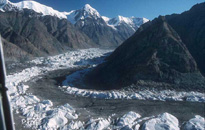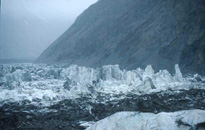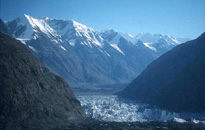



This week, we have facts about Merzbacher Lake in Kyrgyzstan. This glacial lake was discovered 100 years ago and just about every year since, its icy dam has broken and released a deluge in the valleys below.
KNOY: Welcome back to Living on Earth. I'm Laura Knoy.
[MUSIC: Vanilla Ice “Ice Ice Baby” To The Extreme]
KNOY: One hundred years ago, German explorer Gottfried Merzbacher led an expedition through the Tien Shan Mountains in modern Kyrgyzstan. There, on the western edge of the Himalayas, he discovered a remote glacial lake. In a lengthy chronicle of his travels, he hardly mentions the lake that now bears his name. But he just saw it on the wrong day. Later, visitors learned of its dynamic nature. Almost every year, Merzbacher Lake appears, expands, dies a spectacular death, and is reborn. Its evolution takes place in a steep, virtually inaccessible valley where two glaciers meet. When the spring sun begins to melt the ice, water flows into the valley, collects on top of the glacier's ice, and is penned in by an ice dam.
 |
 |
|
 |
 |
|
| (Photos: Stephan Schoen / Saechsische Zeitung (Dresden)) | ||
At the peak of its cycle, the lake has an area of about five square kilometers. But by then it's late summer, the temperature is rising, and like a bottle of fine champagne, a cork of ice pops out from the base of the dam and water bursts free in an icy explosion. In just three days, the lake disappears and the cycle begins again.
Even one hundred years after its discovery, westerners still don't know much about Merzbacher Lake. Scientists are currently investigating the area's geology, and updating Soviet-era maps of the region using satellite images to better understand this natural wonder.
And for this week, that's the Living on Earth Almanac.